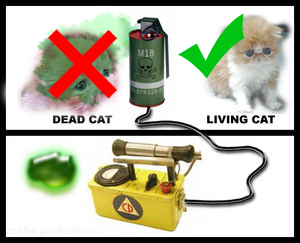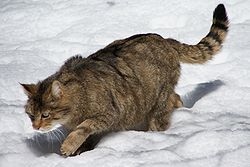User:Alficiro/Cat
- for the clade of all felids, see Felidae

| Live, reproduce, die Biology |
| Life as we know it |
| Divide and multiply |
| Great Apes |
Domestic cats (Felis catus) ![]() are a popular [[cute]] [[pet]].
are a popular [[cute]] [[pet]].
- planned sections
- Feline behavior
- with other animals
- as invasive species
- Stereotypes of animals § Cats

- toxoplasma gondii
| old | ||||||||||||||||
|---|---|---|---|---|---|---|---|---|---|---|---|---|---|---|---|---|
{{balloons}}
A cat is a cute domestic or wild animal Cats![edit] Largely Offensive Weapon Of Claw
A domestic cat (Felis catus or Felis silvestris catus, depending on whom you ask) is a member of the Felidae, or feline, family of animals, readily identifiable by its adorableness, other affiliated quirks and charms, or from the rancid blood of baby chickadees that clings to its flea-ridden fur. A cat is a vicious evil mini-lion that will rake its claws across a human's face when it is being petted.[6] Other than that, the main contribution cats make to our lives is their ability to move with supernatural grace and while the outdoor cats earn the well-deserved ire of New World Cats are (usually) the natural enemies of all other smaller life forms and delight in torturing smaller beasts by killing them slowly. Examples include mice, rats, or, if the cat is exceptionally lucky, a long-eared jerboa. The only animal smaller than a cat that the cat does not do such to is a smaller dog, the smallest dogs (usually terrier breeds) that the cat might treat as if a fellow cat. Cats carry in their little heads a detailed mental map of every place they frequent, and are visibly startled when a new object appears - especially if it is another cat or a person screaming and running to have it get the fuck off the yard. This being a rather effective adaptation for a relatively small animal that must contend with some much larger predators including coyotes and owls (neither which have decimated wildlife on the same degree cats have done), cats will often explore whatever additions or alterations they find to ensure their awareness of any and all gaps they may hide in, and whether or not such gaps can be used for ambush purposes. Cats are an interesting quirk of evolution - at an early point in human history (roughly 12,000 years ago)[note 1] wildcats Felines in fact might have been domesticated twice, as the unrelated Leopard Cat (Prionailurus bengalensis) has a now extinct domesticated Chinese subspecies, which underwent extinction as it was replaced by typical Felis catus in human homes.[8] Ancient Egypt was thought to be the first civilization to domesticate cats, but that has been proven false. The Egyptian word for cat is "Mau," which sounds awfully like "meow." They worshipped Bastet, a cat-headed goddess. In return for food, drink, excrement removal, bed, and universal health care, a cat gives back companionship and a daily lesson in how to move. Occasionally a cat will present its A human cannot decide that a cat will like a particular food; the more a person so believes, the more likely the cat is to spurn it — that is, unless it is tuna: cats will only eat food that they can smell, and fish foods definitely rank among the most odoriferous. A cat unfed for a certain period of time (currently estimated at seventeen minutes but subject to future testing) is in danger of expiring from starvation. This is evidenced by pityful "wowlings" at its human servitors and fixed staring at anything being eaten or drunk by them. Cats are the Inspection Officers of their households - no new item or being may be introduced to the cat's place of abode (it is their place of abode, not yours) without the Inspection Officer giving it the once over. If it is an object, it will need to be sat on—or in—to test it for suitability. If it is an item of comfort, such as a cushion, blanket or human being, the Inspection Officer must use it first to ascertain its cosiness. An empty box must be occupied and defended. All items leaving the household must also be inspected——for example, suitcases.[9] Even glasses cannot be spared. If a cat sleeps on a human's bed, it will have preferred locations that are calculated to be the most inconvenient/painful for the other occupants. Prior to curling on the lower abdomen or immediately beneath the chin, the cat will stamp around with claws extended, with the potential of causing extreme damage to irreplaceable parts of their human servitors. Cats also enjoy setting a bear trap for their owners in the form of rolling onto their backs with a sweet look on their face while exposing their tummies, thus enticing human hands into the focal point of all four razor edged paws and teeth. Within a split second of initial hand-to-tummy contact, the trap is triggered, and the owner's hand becomes clamped into a barrage of scratching, biting, and strange back-legged cycle kicking. Despite the resultant injuries from such an attack, cat owners have been known to fall for this trap multiple times, some possibly enjoying it. (Protip: they're asking for head scratches). Cats are known enemies to things like "productivity", as this well-documented photo essay will attest to. Infant cats are called kittens, and are even deadlier than normal cats due to their even sharper claws and their ability to override all rational thought in nearby humans. But they are oh-so-cuu-uute! People seem to be incapable of neutrality towards cats. They either love them or hate them. Bird lovers probably hate cats the most. Dog lovers also seem to hate cats a lot, though there are rather a lot of oddballs who keep both types of pet in the same household successfully. In such cases, the dog might treat a cat as if a puppy and have a wholesome relationship. Cats are able to sniff out those who are not enamoured and will preferentially approach, snuggle and rub against them. Persons allergic to cats are especially likely to be treated in this manner. Amazing facts about cats that you won't believe[edit]
Some cats[edit]
Purrrversity[edit]
"If cats looked like frogs we'd realize what nasty, cruel little bastards they are. Style. That's what people remember." — Terry Pratchett (Lords and Ladies) "And though you are not sentient and do not comprehend, I nonetheless consider you a true and valued friend." — Data (Star Trek: The Next Generation)[16] "Cat? Cat! Cat! It's a cat!" — Dormouse (Alice in Wonderland) See also[edit]Don't see also[edit]External links[edit]
Notes[edit]
References[edit]
[[Category:Animals]] [[Category:Cats]] [[Category:Deities]] [[Category:We're on a mission from Ceiling Cat]] |









































